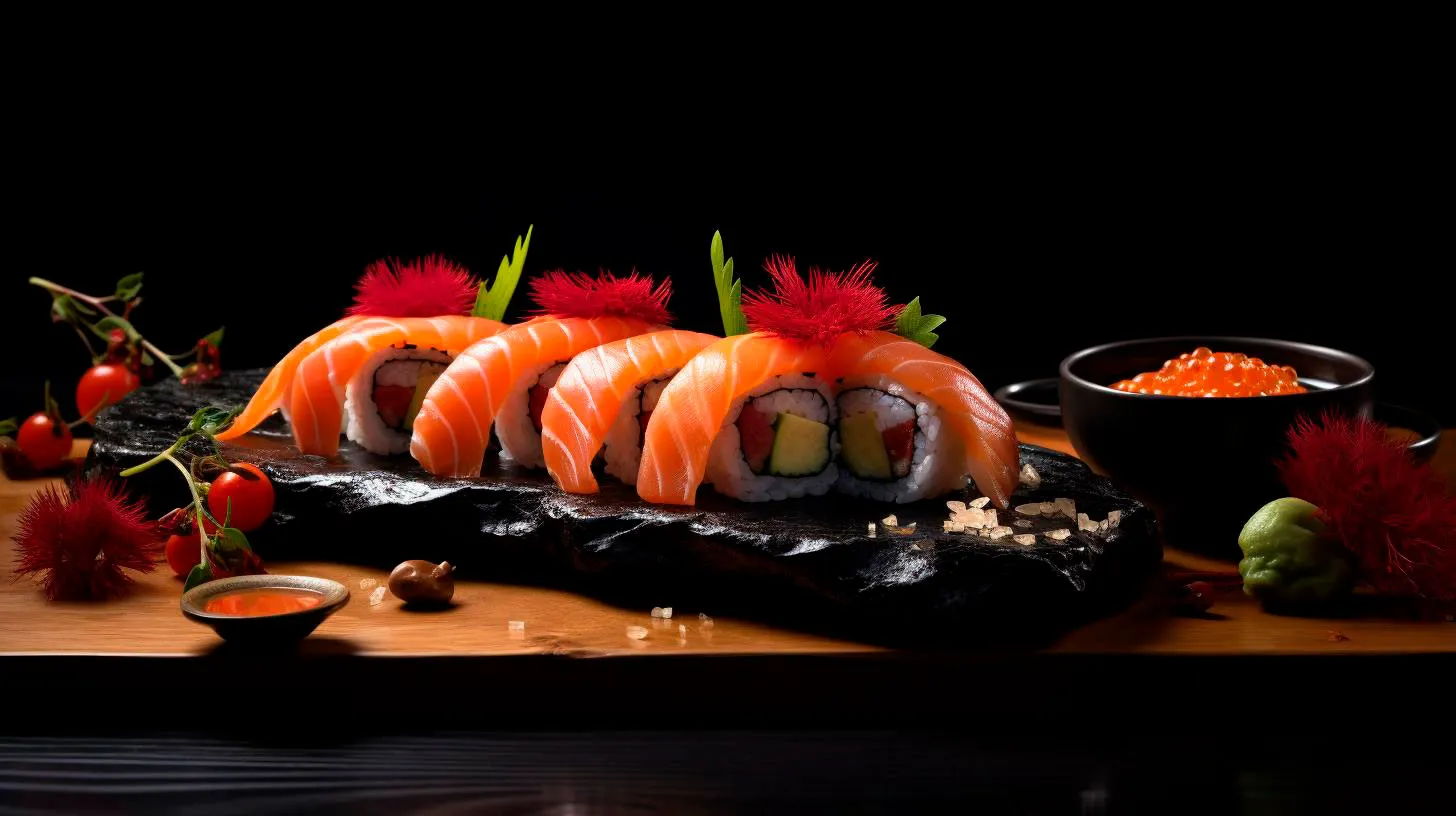From Tokyo to New York: The Business of Sushi and its Global Market Impact
In this article, we will explore the fascinating business of sushi and delve into its influence on the global culinary scene.
The Sushi Market: A Global Perspective
Over the past few decades, the sushi market has experienced remarkable growth. According to Grand View Research, the global sushi market size was valued at USD 22.5 billion in 2020 and is expected to reach USD 32.88 billion by 2028, growing at a CAGR of 4.9%. This surge in demand can be attributed to a variety of factors:
- Health Consciousness: As people become increasingly health-conscious, sushi’s perceived health benefits have made it a popular choice. Sushi is low in calories, high in protein, and often includes nutrient-rich ingredients like fish, seaweed, and vegetables.
- Globalization and Travel: Thanks to globalization, cuisines from different parts of the world have become accessible to a wider audience. As more people travel and experience sushi in its home country of Japan, the demand for authentic sushi experiences has grown exponentially.
- Variety and Innovation: Sushi has evolved beyond traditional raw fish and rice rolls. With the emergence of fusion sushi, vegetarian options, and creative flavor combinations, sushi has captured the attention of both traditionalists and adventurous eaters.
- Perceived Exclusivity: Sushi has developed a reputation as a luxury food item, especially in Western countries. The exclusivity associated with sushi has created a sense of sophistication and desirability, driving up demand.
The Business of Sushi
Running a sushi restaurant entails more than just serving raw fish. It involves careful sourcing, meticulous preparation, and creating an exceptional dining experience for customers. Here are some key aspects and challenges of the sushi business:
1. Quality Ingredients
The success of a sushi restaurant hinges on sourcing the highest quality ingredients. Fresh fish, authentic Japanese rice, and premium seaweed are essential components of a great sushi experience. Establishing relationships with trusted suppliers and ensuring a steady supply of top-notch ingredients is crucial for long-term success.
2. Skillful Chefs
Sushi is an art form, and skilled chefs are the heart and soul of a sushi restaurant. These experts undergo years of training to perfect their craft, learning the delicate techniques of fish slicing, rice preparation, and flavor balance. Hiring and retaining talented sushi chefs is a significant challenge for restaurant owners.
3. Consistency and Quality Control
Consistency is paramount in the sushi business. Customers expect the same level of quality and taste with every visit. Maintaining consistent standards and ensuring quality control across the sushi-making process is essential to build a loyal customer base.
4. Customer Experience and Ambience
Creating a memorable dining experience extends beyond the food itself. Sushi restaurants often strive to provide an immersive and authentic environment, resembling traditional Japanese settings. From the decor to the presentation of the dishes, every detail matters in creating a unique atmosphere for customers.
The Global Impact of Sushi
As the popularity of sushi continues to expand worldwide, it has had a significant impact on various aspects of the global economy:
1. Employment Opportunities
The growth of the sushi industry has led to a surge in employment opportunities. From sushi chefs to restaurant staff and suppliers, this expanding market has created jobs worldwide. According to Statista, the number of sushi restaurants in the United States alone has more than doubled over the past decade.
2. Boosting Local Economies
Sushi’s impact goes beyond the restaurant sector. Fishing communities, rice growers, and seaweed farmers have benefited from the increased demand for ingredients. This has contributed to the economic growth of regions involved in the production and supply chain of sushi-related products.
3. Tourism and Cultural Exchange
Sushi has become synonymous with Japan’s culinary heritage. As travelers seek authentic gastronomic experiences, countries like Japan have witnessed a rise in food tourism. This cultural exchange has fostered a deeper understanding of Japanese traditions and cuisine.
4. Influencing Culinary Trends
The popularity of sushi has influenced culinary trends on a global scale. The focus on fresh, healthy ingredients and innovative flavor combinations has permeated other cuisines as well. Sushi’s influence can be seen in fusion dishes, the rise of poke bowls, and the emphasis on sushi-grade fish in various seafood dishes.
Key Takeaways
- The global sushi market continues to grow, driven by health consciousness, globalization, variety, and exclusivity.
- The business of sushi requires sourcing high-quality ingredients, skilled chefs, consistency, and creating a memorable customer experience.
- Sushi’s global impact extends to employment opportunities, local economies, tourism, cultural exchange, and culinary trends.
- Sushi’s popularity shows no signs of slowing down, and entrepreneurs who tap into this market have the potential for long-term success.
From Tokyo to New York and beyond, sushi has transcended cultural boundaries to become a beloved global cuisine. Its journey from a traditional Japanese dish to a thriving international market showcases the power of culinary innovation and cultural exchange. As we embark on our own sushi adventures, let us appreciate the business behind this delectable delicacy and the impact it has on our palates and economies.
Sushi Fusion: The Intersection of Traditional Japanese Cuisine and Global Flavors
This fusion of traditional Japanese techniques with international ingredients has given birth to a captivating and tantalizing culinary experience called Sushi Fusion.
The Evolution of Sushi Fusion
Sushi itself has a rich history, dating back to ancient Japan. Originally, it was a simple dish of fermented fish and rice, traditionally wrapped in seaweed. However, as globalization brought people and cultures closer together, sushi began to evolve. Chefs started experimenting with different ingredients and cooking techniques from various cuisines, creating unique and exciting flavor profiles.
Today, sushi fusion offers a wide range of options, blending traditional sushi components with ingredients and flavors from countries like Thailand, Mexico, Italy, and more. This culinary fusion is not constrained by geographical boundaries or culinary traditions, and the possibilities are endless.
Key Takeaways:
- Sushi fusion combines traditional Japanese techniques with international ingredients.
- It offers a wide range of flavor profiles, taking inspiration from cuisines around the world.
- Fusion sushi has evolved as a result of globalization, bringing people and cultures closer together.
The Flavors of Sushi Fusion
One of the most enticing aspects of sushi fusion is the explosion of flavors it offers. By incorporating ingredients like mango, jalapeno, avocado, and even truffle oil, sushi fusion chefs create unique combinations that excite the taste buds. The marriage of sweet, savory, spicy, and umami flavors creates an unparalleled gastronomic experience.
Whether it’s a Thai-inspired sushi roll with peanut sauce, cilantro, and lime zest or a Mexican-inspired roll with jalapenos, cilantro, and salsa, the fusion of flavors in sushi is a delight for adventurous food lovers.
Key Takeaways:
- Sushi fusion introduces a burst of flavors through international ingredients.
- The incorporation of sweet, savory, spicy, and umami flavors creates a unique gastronomic experience.
- Different cultures inspire diverse flavor combinations, making every sushi fusion dish a culinary adventure.
The Presentation and Aesthetic Appeal
Another aspect that sets sushi fusion apart is its visually striking presentation. Chefs incorporate artistic techniques like colorful sauces, edible flowers, and creative plating to enhance the aesthetic appeal of their dishes. This attention to detail elevates the dining experience, making it more than just a meal.
Whether it’s a beautifully arranged sushi platter with a variety of vibrant rolls or a sushi burrito wrapped like a work of art, sushi fusion delights both the eyes and the taste buds.
Key Takeaways:
- Sushi fusion emphasizes the aesthetic presentation of dishes through artistic techniques.
- Colorful sauces, edible flowers, and creative plating enhance the visual appeal.
- Both the taste and the presentation play vital roles in the overall sushi fusion experience.
Health Benefits of Sushi Fusion
Not only is sushi fusion a treat for the senses, but it also offers several health benefits. Fresh ingredients are a cornerstone of sushi fusion, ensuring a nutrient-rich experience. Seafood, a key component of sushi, is a great source of lean proteins, omega-3 fatty acids, and essential minerals.
The incorporation of vegetables, such as cucumber, avocado, and carrots, further enhances the nutritional value of sushi fusion. Additionally, the smaller portions typical of sushi allow for better portion control, making it a healthier option compared to larger, calorie-dense meals.
Key Takeaways:
- Sushi fusion incorporates fresh ingredients, offering a nutrient-rich dining experience.
- Seafood provides lean proteins, omega-3 fatty acids, and essential minerals.
- Incorporation of vegetables enhances the nutritional value of sushi fusion.
The Growing Popularity of Sushi Fusion
Sushi fusion has gained immense popularity worldwide, attracting not only sushi enthusiasts but also adventurous food lovers keen to explore new flavors. The fusion of traditional Japanese techniques with global ingredients has expanded the horizons of sushi, appealing to a wider audience.
In fact, according to a recent study, the global sushi market is projected to reach a value of $26.7 billion by 2024, with sushi fusion playing a significant role in this growth. This trend is indicative of the ever-increasing appreciation for unique, flavor-packed culinary experiences.
Key Takeaways:
- Sushi fusion has gained popularity among both sushi enthusiasts and adventurous food lovers.
- The global sushi market is projected to reach $26.7 billion by 2024.
- Sushi fusion’s growth highlights the demand for unique culinary experiences.
Embrace the Sushi Fusion Experience
With its captivating blend of flavors, artistic presentation, health benefits, and growing popularity, sushi fusion offers a culinary journey like no other. Embrace the fusion of traditional Japanese cuisine with global flavors and embark on a gastronomic adventure that will tantalize your taste buds and leave you craving for more.
Discover the innovative combinations, relish the intricate presentation, and savor the unique flavors that define sushi fusion. Indulge in this culinary fusion and immerse yourself in the world of sushi like never before.
Sushi Goes Global: Exploring the Popularity and Evolution of Sushi Worldwide
In this article, we will delve into the sushi’s journey from obscurity to international fame, exploring its key features, advantages, and the reasons behind its widespread appeal.
The Rise of Sushi: A Global Perspective
Sushi originated in Southeast Asia over 2,000 years ago but gained popularity in Japan during the Edo Period. It was initially consumed as a form of preserved fish, with fermented rice used as a way to preserve the fish during the fermentation process. Fast forward to the early 20th century, sushi transformed from street food to a staple dish in Japanese cuisine.
The true globalization of sushi, however, began in the 1960s when sushi chefs from Japan started to migrate to different parts of the world. This spread of skilled chefs and their expertise led to the establishment of sushi restaurants outside of Japan, allowing locals to experience the authentic taste of this traditional delicacy. The rise of air travel further catalyzed sushi’s globalization as it became easier to import ingredients directly from Japan, ensuring the freshness and quality of the sushi served worldwide.
The Features and Advantages of Sushi
Sushi’s appeal lies in its unique combination of flavors, textures, and presentation, making it a visually appealing and gastronomically satisfying dish. Here are some key features and advantages of sushi:
- Health Benefits: Sushi is often considered a healthy option as it is low in fat and calories. It is packed with omega-3 fatty acids, vitamins, and minerals, thanks to its primary ingredient, fish.
- Variety: Sushi offers a wide range of options to suit various tastes and dietary preferences. From classic nigiri and maki rolls to inventive fusion creations, there is something for everyone.
- Freshness: Sushi is synonymous with freshness. Ingredients are carefully selected, and the skilled craftsmanship of sushi chefs ensures the highest quality of each bite.
- Artful Presentation: Sushi is not only delicious but also visually stunning. Chefs meticulously arrange each piece, creating edible masterpieces that are as pleasing to the eye as they are to the palate.
Sushi’s Global Impact
The globalization of sushi has had a significant impact on both the culinary world and local economies. Let’s explore some key takeaways:
- Economic Growth: Sushi’s popularity has led to the growth of the global seafood industry. According to research, the global sushi market is expected to reach a value of $22.4 billion by 2025.
- Tourism and Cultural Exchange: Sushi has become a cultural ambassador, attracting tourists who seek an authentic culinary experience. Restaurants that serve sushi have emerged as destinations, contributing to the tourism industry’s growth.
- Health and Sustainability: The emphasis on fresh ingredients and quality seafood has fostered awareness of sustainability in the fishing industry. Consumers are increasingly demanding sustainably sourced fish for their sushi, driving positive changes in fishing practices.
The Evolution of Sushi: Fusion and Innovation
As sushi continues to captivate global palates, chefs around the world are putting their own spin on this traditional Japanese dish. Fusion sushi, which combines flavors from different cuisines, has become increasingly popular. From sushi burritos to sushi pizzas, these innovative creations reflect the evolving tastes and preferences of diners. This fusion of flavors adds a new dimension to sushi, attracting even more food enthusiasts to explore this internationally beloved cuisine.
Furthermore, advancements in technology have revolutionized the sushi dining experience. Conveyor belt sushi (kaiten-zushi) and automated sushi robots have simplified and accelerated the sushi-making process, meeting the ever-increasing demand for this delectable dish. These technological advancements have not only made sushi more accessible but also enhanced efficiency in restaurants.
The Future of Sushi
With the global popularity of sushi showing no signs of slowing down, its future looks promising. The continuous evolution of sushi, along with the integration of technology and growing sustainability practices, ensures that sushi will remain a sought-after culinary delight worldwide.
In conclusion, sushi’s journey from its origins in Japan to becoming a global sensation is a testament to its unique flavors, health benefits, and captivating presentation. Its popularity has not only impacted the culinary scene but has also contributed to economic growth, cultural exchange, and sustainability in the fishing industry. As sushi evolves with fusion flavors and technological advancements, its global appeal will undoubtedly continue to grow, attracting food enthusiasts from all walks of life.
The Rise of Sushi: How Globalization Shaped Japan’s Culinary Tradition
In this article, we will explore the rise of sushi and its journey from a local Japanese dish to an international sensation.
The Origin of Sushi: A Traditional Japanese Delight
Sushi can trace its roots back to ancient Japan, where it was initially consumed as a way to preserve fish. The concept of fermenting rice and fish was a brilliant culinary innovation that not only prolonged the shelf life of the ingredients but also created a unique flavor profile.
- Traditionally, sushi consisted of fermented fish rolled in rice and served as a quick snack.
- Nigiri sushi, a popular variation, introduced the concept of placing a slice of raw fish on top of a small mound of rice.
- Sashimi, another beloved Japanese dish, is often mistaken for sushi. However, it consists solely of thinly sliced raw fish or seafood, without the rice component.
The Influence of Globalization
As Japan embraced globalization and opened its doors to the world, sushi began to evolve. It gained international attention during the mid-20th century when Japanese immigrants introduced it to the United States. This marked the beginning of its expansion and transformation into the globally beloved culinary art form we know today.
- The invention of the California Roll in the 1960s was a significant turning point. Chef Ichiro Mashita, who found it difficult to source traditional sushi ingredients, substituted them with local avocado and crabmeat. This ingenious creation combined the flavors and textures that appealed to the Western palate.
- Modern sushi also incorporates various non-traditional ingredients, such as cream cheese, mango, and even fried chicken. These innovative twists have further broadened sushi’s appeal, making it adaptable to diverse culinary preferences, dietary restrictions, and cultural preferences.
- The proliferation of sushi restaurants worldwide has made sushi more accessible than ever before, bridging the gap between cultures and allowing people to experience a taste of Japan.
The Global Popularity and Health Benefits of Sushi
The global popularity of sushi is undeniable, with countless sushi restaurants popping up in cities across the globe. So, what makes sushi so special? Let’s explore some of its key advantages and health benefits:
- Nutritional Value: Sushi is a healthy choice packed with essential nutrients. It is a good source of lean protein, omega-3 fatty acids, and vitamins and minerals.
- Low in Calories: Sushi is generally low in calories, making it a suitable option for those watching their weight.
- Cultural Appreciation: By enjoying sushi, one can embrace Japanese culture and appreciate their dedication to simplicity, balance, and presentation.
- Variety: Sushi offers a wide range of options to cater to different tastes, including vegetarian and vegan alternatives.
- Social Experience: Sharing sushi rolls with friends and family enhances the social aspect of dining and creates memorable experiences.
Key Takeaways
The rise of sushi as a global phenomenon exemplifies how globalization has shaped Japan’s culinary tradition. By adapting to local tastes, incorporating non-traditional ingredients, and promoting cultural exchange, sushi has become a symbol of globalization’s impact on food. Here are the key takeaways:
- Sushi originated in Japan as a way to preserve fish, and its flavors have evolved over time.
- Globalization played a vital role in popularizing sushi outside of Japan.
- Sushi’s adaptability and innovative variations have contributed to its worldwide success.
- Embracing sushi allows individuals to experience the cultural richness of Japan while enjoying its health benefits.
The journey of sushi from a humble Japanese delight to an international sensation is a testament to the power of globalization in shaping culinary traditions. So, the next time you savor a piece of sushi, remember the rich history behind this globally cherished dish.



